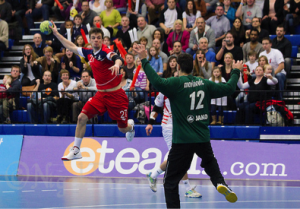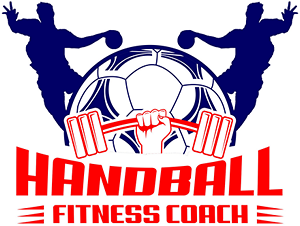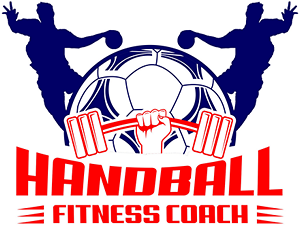Handball & the Olympic Lifts
The Olympic lifts are the clean and press, and the snatch, as well as the different variations of these (power clean, power snatch etc.) These exercises are commonly used by coaches and athletes in other sports outside of Olympic weightlifting, with the primary aim being to improve power output. In other words, being able to apply strength quickly;
- Strength is just simply performing the work (lifting the weight for example), regardless of the duration it takes,
- Power is time dependent, and is the product of performing this work in as quick a manner as possible. Coaches and sportspeople have used these lifts for years, and their spread into the ‘mainstream’ of fitness has come about largely as a result of the spread in popularity of crossfit, in which the Olympic lifts and their various derivatives feature prominently. But how useful are they really, particularly for the development of power relevant for use in a game of handball? The most commonly used of the lifts is the clean, or more specifically the power clean, which involves starting in a hanging position (halfway down into a deadlift), then generating a powerful hip thrust, dip and catch the weight on your shoulders in a front squat (or semi-squat) position. The snatch is nowhere near as popular due to the difficulty learning and performing it, as a result of most peoples’ poor postures and shoulder mobility, not to mention whole body mobility.




The power clean off the floor; explosively taking the bar from the floor to racked on the shoulders in a fraction of a second.
I will start by saying the clean and/or power clean is a very effective way of transferring the strength developed from exercises like a deadlift and squat, over to power generation for powerful movement. However, we do not include them in the program section of Strength & Power Training for Handball for several key reasons. The time taken to learn how to clean properly (let alone how to snatch properly) is a lengthy one, with several stages even just in body positioning to gain proficiency in before cleans can even be attempted. Aside from needing to be able to understand and perform the mechanics of both a deadlift and front squat with perfect form and spinal alignment throughout, you then must learn how to hold these spots whilst generating movement at speed as well as sequencing the changes in body position correctly. This takes a lot of time if it is to be learnt and performed correctly. And if it isn’t being performed correctly, not just with how it looks, but more so on the coordination end emphasis in the movement, then there is very little being gained from the exercise.
I can’t emphasise enough just how important perfect performance of this exercise is, not only because of the high chance of injury that exists, but also because of how specific it is in terms of the training adaptions that can be generated from it. Basically what I am saying is that what is a very good exercise when it is executed properly, is also as useless an exercise as it gets when executed poorly. And the simple brutal fact is that 95% of people around you doing this exercise are doing it wrong, achieving nothing, and risking injury for no reason in the process. These exercises are also highly specific with sets and rep counts, and are designed to be performed at very low rep counts (around a maximum of 3 per set). Yet a lot of the time, they are being performed in high reps (particularly in crossfit which seems to specialise in poor form and poor programming - with the exception of the Scandinavian countries where the standard of Crossfit coaches are far higher than elsewhere like USA, Australia and Great Britain) and therefore aren’t achieving their primary aim.
Vern Gambetta, a renowned strength and conditioning for sports expert whom we have quoted a lot, also has raised another good point in terms of being cautious as to whether or not the Olympic lifts should be included in a sportspersons training program. He outlined the fact that Olympic lifters are pre- selected based on their body types and more specifically their limb proportions. In short, if you have long limbs you will not succeed as you are not suited to these movements, whilst if you are short with short limbs you are much better physically suited to perform these lifts. Similarly, a long torso with shorter legs is also another physical characteristic that will hamper your ability with these movements. Vern Gambetta talks about seeing back injuries in tall basketball players who were required to perform various Olympic lifting movements without recognising the need to adapt the exercises or the program to better suit their body types. I think Vern says it perfectly in saying ‘adapt the method to the athlete, don’t adapt the athlete to the method.’
So the steep learning curve associated with Olympic lifting isn’t just to do with learning the actual movement itself, but also with being coached with proper programming, on top of hopefully having the appropriate limb lengths or appropriately abbreviating the exercise to accommodate your limb lengths, as well as being directed with how best to integrate it into your own training program for your sport. In other words, if you aren’t being taught the Olympic lifts by a qualified coach, don’t perform them. There is a such a high degree of difficulty associated with learning them, especially on your own, with such a low potential payoff as a result of the low likelihood of them being done correctly. Furthermore, to learn them properly normally means making them a sole focus of your training program for a particular period or training block, and unless you are a full time handball player, this time simply does not exist. In fact even as a full time handball player, your time for weights is still relatively small given all the other preparation for handball required.
However, importantly, if you do choose to learn how to do these lifts with some coaching, do this with a proper qualified coach (official Weightlifting Federation in your country), not a guy who has done the crossfit ‘course’, or a friend who has watched some videos on YouTube, or someone else you know who used to train with a guy who knew how to do them, but rather some actual proper 1 on 1 coaching from someone suitably qualified in ensuring you are learning and performing them properly, in order to get something out of them. Short of this, just leave them out, there is so little extra to be gained from doing them, in minimal available time, especially if done incorrectly.
A final point – Are they that great anyway? (In terms of carryover to the goal)
As far as Olympic lifting, our argument for leaving them out of our programming is relatively similar to that in regards to leaving the bench press out, or not focusing so heavily on the bench press at least. A combination of the risk of injury (particularly in regards to the taller bodies and lever lengths), as well as a questionable level of genuine carryover for our goals in handball, particularly when considering how long it takes to learn to execute the exercises properly.
As we have covered, the power generated in handball movements is that involving the stretch-shorten cycle of muscle and tendon (or the plyometric movement.) On the other hand, the clean as well as snatch and the abbreviated versions of these develop only the concentric portion of power output (as there is no stretch or eccentric prior to the movement.) Whilst initially seeming like a minor difference, this is important as the counter-movement style of power generation not only needs to be trained specifically (in order to appropriately condition and coordinate the sequencing of the muscle action), but also because as mentioned earlier, this stretch-shorten cycle allows for a greater expression of power than without the pre-stretch. (If you want simple proof of this record your jump height after a normal stationary jump where you dip down and jump, then record it again by lowering into the bottom and pausing for a few seconds to take the pre-stretch out, and then try and jump. You will realise that without this pre- stretch and quick snap back, the height is no where near as high, nor is the speed of the jump itself.)
Movement patterns and relative timing are also key issues here when considering the effectiveness of Olympic lifting for handball training. For starters, the movement patterns and power expressions in handball are quite different to that stationary double leg hip drive in an Olympic lift. Whether it is shooting or accelerating or sidestepping and changing directions the movements are all off 1 foot. Perhaps even more importantly (certainly from an injury prevention point of view) these movements all have important eccentric muscular actions, especially decelerating and changing directions – something that plyometric training trains very well and in very specific and adjustable patterns, but which the Olympic lifts certainly do not.
“Change of direction performance appears to be both independent of hang power clean scores and similarly unresponsive to training involving standard weightlifting movements.”
“This may be a consequence of the bilateral nature and predominantly vertical force production that is characteristic of the classical weightlifting movements.”
Paul Gamble
Strength & Conditioning For Team Sports
Whilst there is no doubt in the link that has been shown between Olympic lifting and vertical leap, we must remember that there are more movements associated with power production in handball than just vertical leap – and vertical leaps in handball certainly aren’t the stationary vertical leap. ‘But we could do Olympic lifts and plyometrics’ may be the response. We could, but how much training time is available? Remember we are aiming as getting as much as we can out of as little as possible, and with time being an issue, the long length of time taken to learn the lifts correctly is simply not worth it, when we consider how much more effective, flexible and adaptable plyometrics can be – and to all body shapes, not just those with the right lever lengths for Olympic lifting. So just as with the bench press, if you love your Olympic lifts, go for it – but don’t do these at the expense of what we believe are better exercises.



An effective alternative to Cleans – The Kettlebell Swing
(A much simpler alternative to Olympic lifts – but very effective)
Aside from our plyometric work, another option that exists for a power generating exercise that is similar to the clean and power clean, in its generation of a powerful hip movement is the kettlebell swing. This is a much simpler exercise to learn, although to learn with proficiency also takes a little time, however the learning curve is nowhere near as steep. There are several ‘studies’ out there which have shown kettlebell swings showing equal, as well as greater gains in power output in a short amount of time than training with cleans, however I admit such ‘studies’ as well as studies in general, must be taken with a grain of salt, as there are any number of variables which could also effect such findings. However, the key point is that the kettlebell swing is a relatively easy exercise to learn, which incorporates a powerful and explosive hip movement when done properly, and it can easily be slipped into a program, as they don’t need to be programmed as specifically and carefully as the Olympic lifts.


However, a key point to note here is that the kettlebell swing, just as with the Olympic lifts, must be performed correctly to be effective and useful for us. And just as with the Olympic lifts, 95% of people you see doing these around you, are doing them wrong. Be part of the 5%.
So whilst plyometric and medicine ball work are the 2 primary forms of power based training that we use when developing our power for handball on top of our strength platform, the kettlebell swing is also included in the exercise catalogue as a powerful expression of hip drive.
“If you are into vertical jump training, the kettlebell swing is a must- know, must-do tool in your athletic arsenal. They have a high biomechanical transfer to leaping ability, they overload the hips well when performed properly, they can provide a strong eccentric loading of the posterior chain, they are easy to learn and the stupidity factor is low.”
Joel Smith
Using Existing Strength exercises as Power exercises
An important thing to note about training for power, is that to be a power- focused exercise, the exercise doesn’t need to be a new and specific exercise that you haven’t done before. The standard strength training exercises that we have already performed to build our maximal strength and functional strength base can also be adjusted to become more speed and power focused.
The general method here involves taking the strength exercises that have a high level of carryover in movement pattern to the types of movement patterns that we would like to develop explosive power in for games, and changing the programming variables of the exercises (weight used, rest times, repetitions and speed of movement.)
So for example, we would like to develop a high level of power in the single leg jumping motion, hence the weighted step-ups and the plyometric step-up jumps. However, we can also reduce the weight of the standard step-ups, and focus on stepping up and performing each repetition with as much speed as possible. Here we are focusing on the rate of force development, or the ability to develop force within a limited timeframe.
There is however a limitation to these exercises as power focused exercises, and that is that there will always be a deceleration towards the end of the movement. That is, when performing a fast step up with less weight than normal for example, as you get towards the end of the movement, there will be a natural slowing of the movement (it must slow because it must come to a stop.) Plyometric exercise and medicine ball exercises on the other hand, allow for maximum power and acceleration through the full range of motion.
We quoted Paul Gamble a little earlier discussing the merits of medicine ball training/ballistic strength training, and these thoughts become relevant again here when considering the limitation of traditional strength exercises as power exercises. When talking about ballistic training he says ‘this form of training is unique in that the load is released or projected into free space at the end of the movement, and it is this characteristic that makes ballistic resistance training superior to conventional strength training exercises in developing elements of explosive muscular power.’
So whilst there is some merit in lowering the weight at times and looking to move it quickly (a fine balance between the weight lifted and the speed of movement for optimum power generation) as a ‘bridging’ form of training between standard strength work and then speed strength, there is this limitation to consider. For this reason, we believe that the combination of standard strength exercises combined with plyometric and medicine ball work for power is the optimal combination. However performing strength exercises executed at higher speeds does have merit and can be used to change the stimulus of training when programmed correctly. As always, there are literally thousands of ways that you could, potentially go about training and programming. However there is only so much time, and therefore it is important to optimize and be very selective. We cant do everything. It is also important to note that this is a quite advanced form of strength training.

Fitness Coach
